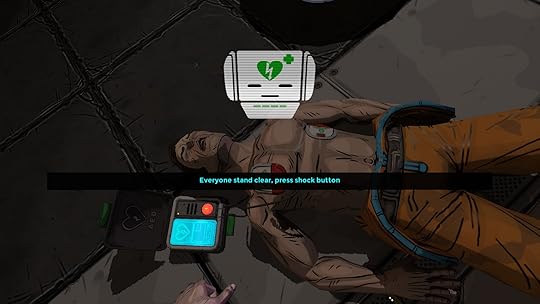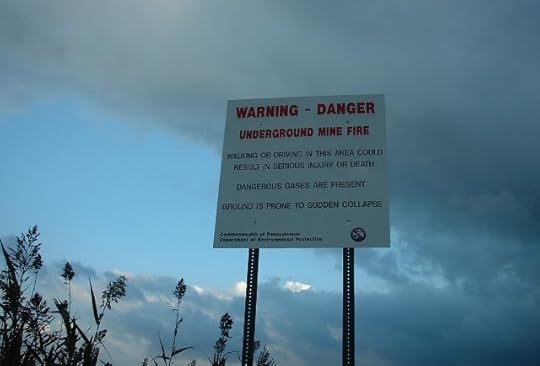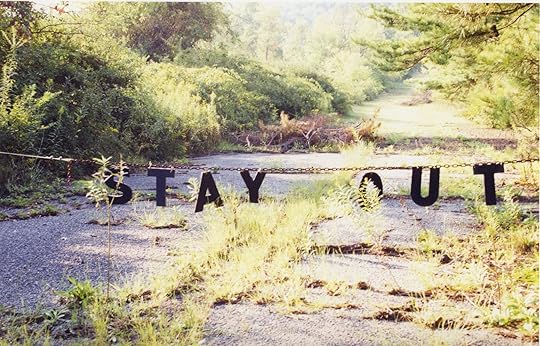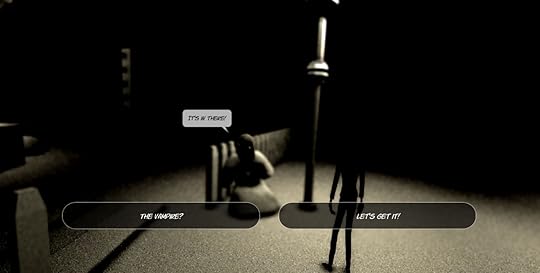Kill Screen Magazine's Blog, page 209
October 20, 2015
How One Astronomer Uses Art to Understand Science
Creativity can help us understand the art of astronomy.
October 19, 2015
A videogame that teaches you the basics of CPR
"You know all this shit," shouts Conan O'Brien, "but you don't know who our second president was!"
This outburst happened during Conan's early look at Super Smash Bros. last year. He's amazed that his partner for the video, Aaron Blair, knows who all of the 50-plus characters in the game are, but doesn't know what most would consider basic American history. It's exemplary of the kind of information some videogame fans so easily absorb while struggling to retain knowledge belonging to the world we live in.
These people only have a 20 percent chance of living
Blair isn't an exception here. It's typical of fans of a TV show or videogame—whatever format the fiction takes—to know more about it than they do anything else. The science is simple: they care about this fictional world and therefore they take time to learn everything about it. This enthusiastic learning process is why there are attempts to infiltrate the world of videogames with what are usually deemed "serious" topics. The latest of those is called Relive. It's a game that teaches its players the basics of CPR.
The Italy-based Studio Evil made the game alongside Federico Semeraro who works as a specialist on emergency medicine and anesthetics. Semeraro deals with people who don't receive CPR within the first six minutes of a trauma and cardiac arrest every one of his working days. These people only have a 20 percent chance of living and so he's been on a mission to up that percentage in any way he can.

Relive is only one of the projects Semeraro is using to spread awareness and interest in learning CPR to people. The demographic in this case is teenagers and young adults. The thinking behind it seems sound enough. They like videogames, right? But a history of bad educational games tells us that it's not enough to simply inject the subject into a videogame format. You have to get players interested in the fiction first.
This is why Relive surrounds its CPR lessons in a swathing sci-fi story about a facility on Mars going awry. There's the usual made-up place names, a "nanites storm," secrets to find, and plenty of item-based puzzle solving. If you came here to learn about CPR you may find yourself half-an-hour or more into the game shouting "Get to the point!" at your screen.
it makes sense that there would be people who need CPR.
The thinking behind this is that, if all of the world-building and more typical videogame elements weren't included, then its intended audience wouldn't be interested. They probably wouldn't even play the game in the first place. And so the equivalent to what Semeraro and Studio Evil have come up here would be trying to teach Conan's assistant who all of America's presidents are and when they held office by making them playable characters in Super Smash Bros.
As silly and unmasked as this method might be it has a good chance of working. Relive essentially turns CPR into a videogame mechanic and, importantly, blends it in with the rest of the story. The whole game is a sci-fi disaster gone wrong and so it makes sense that there would be people who need CPR. It's actually quite refreshing to play a game like this that doesn't have you either shooting aliens and looting the dead bodies you find. You have a chance to save people instead.
Of course, we have to be realistic about how much Relive is doing. Playing it isn't enough to expect anyone to suddenly become a CPR expert. There is a significant difference between doing something in a videogame and applying it to our real-life actions. This is why its creators say that their goal with Relive is only to encourage players "to take CPR classes and be prepared to intervene in case of need." That much should certainly be attainable.
However, Relive also has a CPR Tournament Mode designed for schools and for people to compete at doing CPR with friends and family. It requires a CPR dummy as well as a Microsoft Kinect, which is used to accurately track your movements and score the actions you perform on the dummy. It fills that gap between playing the game and doing formal CPR training. It also enables the most enthusiastic players a means to not only learn how to do CPR but to practice it thoroughly too.
You can download Relive for free over on Steam.
What architects can bring to videogame development
Which direction is north?
The Meeting captures the surreal bliss of falling asleep at work
The Meeting by Matt Bethancourt is a simulation of the secret ritual of the office gathering. It plays almost uncannily similar to those HR-mandated "hang outs" that kick off your work week, where Cindy airs her unending grievances about the break room bandit and everyone votes on when to have the office Christmas party. Following a minimal title screen, The Meeting drops you right into a room where the din of ringing phones underscores the garbled speech of a Peanuts teacher, which presumably belongs to your boss.
give in, let go
But your true enemy in The Meeting is not the wah wah wah of your boss and their less than inspirational speech. It's your eyelids, fighting the repercussions of lack of sleep, or a hangover, or too much Netflix. At the bottom of the screen, a bar fills up while the sounds of the office grow distant. It is your call: do you let the real world get further away, or do you tap your screen to jolt awake? Press the screen, and the world rushes back, with the symphony of phone rings returning in full force. But give in, let go, and you invite a whole new world to engulf you.
Though it's a simple interaction, the wake up mechanic in The Meeting perfectly captures the experience of both fighting sleep and drifting off. There comes a point in every "just resting my eyes" nap where you must decide whether to stay in reality, or, or turn your back on it and give in to the sweet, seductive call of surreality. As in real life, the difference in The Meeting is no bigger than one small and almost unconscious choice.

When the office world begins to vignette, you're given ample time to make the adult decision and return to the meeting. But, wait long enough, and a piece of procedurally generated music begins to play. It sounds like the opposite of your office soundscape: with tinkering bells instead of startling phone rings.
one small and almost unconscious choice
Falling fully into a doze not only opens you up to this pleasant reverie, but also causes all sorts of funny things to happen to your head. Once fully immersed in sleep, your head becomes a floating object in space that can be controlled through your phone's gyroscope. Move it backward and forward through the stars while the music responds to your inputs.
Just be careful that you keep your fingers off the screen. Because even the tiniest of pokes sends you hurtling back into a corporate nightmare. Thankfully, space world remains only a nap away.
You can download The Meeting for free on iOS here.
The evolution of the LAN party
Where PCs and players are put to the test
The tortured existence of the town that supposedly inspired Silent Hill
A new victim of the Silent Hill mythology has been uncovered, and it is neither in the form of a new game or a new movie (thankfully, for the latter at least). A recent addition to The Campo Santo Quarterly Review, a journal curated by the ombudsman of the small yet star-studded game studio of former Telltale talent, details the riveting yet distressing tale of the "the real Silent Hill." Written by Duncan Fyfe, the article "Survival Horror" focuses on the ruined town of Centralia, PA, the begrudging inspiration for the 2006 film Silent Hill.
Though the film was never shot there, nor was the classic videogame series ever even remotely involved with it, a tragic mine fire still damned Centralia, PA to live in the eternal shadows of both franchises. Centralia was abandoned following an underground mine fire that left enormous cracks in the earth which smoked perpetually, eventually awarding it a spot on many "Top 10 Scariest Places in America" internet lists.
an entire town's horrible tragedy
While the underground coal fire that left residents exposed to lethal carbon monoxide poisoning and other hazards that forced them to abandon their homes, the fires should've never reached the town in the first place. But, caught in the dilapidated grips of the bureaucratic monster known as the Reagan administration, any attempts to salvage the town were under-funded and mismanaged. As Fyfe succintly sums it up: "the town of Centralia was simply not politically nor economically valuable enough to get a fire put out." Which, to me, sounds more horrifying than any multi-dimensional purgatory.

But, on top of losing their town to inaction and bureaucratic inefficiencies, the former residents of Centralia were not even left alone to mourn the loss in peace. The director of the 2006 movie inspired by the games, Christophe Gans, cited the town as his main inspiration, causing many fans to incorrectly label it the "real Silent Hill." In turn, the desecrated remains of this once peaceful town became the main attraction for tourists passing through. Aside from just taking fun snapshots of an entire town's horrible tragedy, said tourists leave in their wake an entire wall known as "graffiti highway," covered in cryptic messages and crude dick drawings.
"It’s not supposed to feel like a real place."
The article captures the heart-breaking sentiments from the disenfranchised and forgotten members of the town from a Facebook dedicated to remembering Centralia for what it actually was.“I have to say I love Centralia, lived there all my life,” wrote one former resident. “Had to buy Silent Hill to see it. It was horrible and upset me terribly to know it was inspired by my home town. It was the only movie that I purchased and actually watched and took it outside and smashed. What a sad thing to associate with a place that brought so much joy to so many people.”
Tourists are so hated among ex-Centralia townsfolk that they're blamed for everything from stealing flowers form the local cemetery for souvenirs to leaving behind dead deer carcasses from cult rituals. While some might think the town's hatred is misplaced or unfactual, Fyfe defends their anger when he asks the reader to "imagine being told that someone made a film inspired by your nice town, and what you sit down to watch is the fucking Silent Hill movie."

Not only have these townsfolk been displaced from their homes before seeing their tragedy transformed into the joy of a bunch of misinformed Silent Hill fans, but they can't even claim any relation to the original Konami videogames beloved by so many. Instead, they're left with a B-movie riding on the coattails of that horror franchise's success. Meanwhile, Fyfe points out that, if you go by original intent of the Japanese games, "trying to pin down the longitude and latitude of Silent Hill is pointless. It’s not supposed to feel like a real place." As is evident by the story of the real town only marginally touched by the demonic village's tendrils, “'the real Silent Hill' could be anywhere, anything: whatever form it has evolves in response to different tragedies. It is tragedy."
You can read the full article here.
///
h/t BoingBoing
Why the trailers tell me Assassin's Creed: Syndicate will be bloody awful
Some games you don’t need to play to hate.
October 16, 2015
_Howler_ improves fortune tellers by adding a psychedelic wolf
The magic 8-ball gets an upgrade.
The loving horror of Let the Right One In lives on in this vampiric videogame
"Let the right one in
Let the old dreams die
Let the wrong ones go
They do not
They do not
They do not see what you want them to."
-Morrissey
In the past decade or so, the young vampire romance genre has inspired a couple of foreign films that speak to the classic motif while also seeing beyond it's modern trappings. Let the Right One In (2008), a Swedish title depicting a young twelve-year-old boy who winds up finding an unexpected match in a centuries old immortal child, is an earlier example of the trend. More recently, the first ever Iranian vampire movie, A Girl Walks Home Alone (2014), told a similarly unlikely but visually perfect tale between a male human and his vampire dream girl.
a Scandinavian mentality that tackles vampiric lore in a very specific way
Game designer Kristian Kronstrand's Shih Ho mimics the dynamics of these moody yet sincere takes on a—by now—overtired trope. In the game, a boy finds himself seduced by "Her," an unknown entity that seems connected to a string of murders that happened recently in his slumbering little town. Like Let the Right One In, Shih Ho comes from a Scandinavian mentality that tackles vampiric lore in a very specific way.
As The Guardian points out, "three of Scandinavia's greatest artists, the Swedish playwright August Strindberg, his friend the Norwegian painter Edvard Munch, and the Danish director Carl Dreyer were fascinated by the subject. Virtually all Strindberg heroines are vampires. Munch's most famous painting after The Scream is his Vampyr, while Dreyer's Vampyr is arguably the greatest of all horror films."

Let the Right One In carries one distinct similarity with another Swedish vampire film as well. Anders Banke's Frostbite, set in the Arctic Circle town in Lapland, demonstrates how a vampire can move around freely in a place like Finland, where long winters leave practically no sun to worry about. Let the Right One In director Tomas Alfredson even says the claustrophobia of the small town was central to the essence of the film. Similarly, the town in Shih Ho proves to be all but empty, while the static-y art style conveys the dark and impenetrable winter.
Meanwhile, the young romance sparked in Shih Ho recalls the themes of being pushed and pulled toward good and evil. In Let the Right One In, an innocent-looking yet secretly violent boy falls for a seemingly violent vampire who is actually pretty innocent. The role reversal is also evident in Shih Ho, though in the interactive version the player must decide who he or she is willing to become.
an undercurrent theme of lacking acceptance
Mimicking the beautiful stillness that carries throughout each shot in Let the Right One In, Shih Ho rewards those who know the value of inaction. At one point, a puzzle requires the player to stop moving entirely—"give up"—before it allows her to move forward. Like the other vampire titles, an undercurrent theme of lacking acceptance and even flat out neglect from a parental figure. The kids in these movies find themselves in violent dispositions as a direct result to the brutality of the adult world running parallel to them.

Though the interactivity of Shih Ho leaves some room for an individual player's choice, it captures that Scandinavian sensibility which just might be responsible for the recent revitalization of the young vampire romance genre. Certainly as a film, it's left a lasting impact, which may have even crossed over to games.
You can play Shih Ho for free on Windows, Mac, and Linux here.
Going undercover in a virtual party game
How party game dynamics are influenced by a virtual space.
Kill Screen Magazine's Blog
- Kill Screen Magazine's profile
- 4 followers



